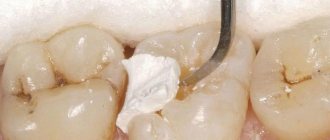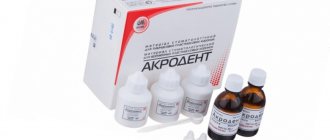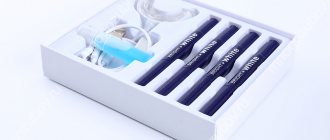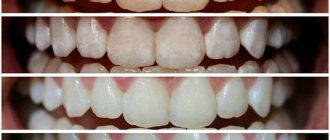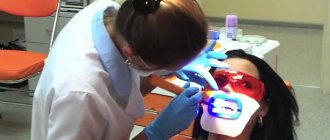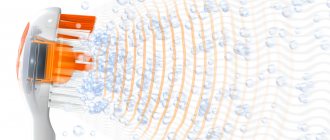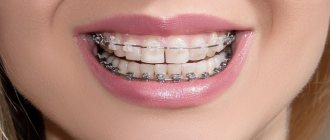What is the essence of the method
The natural color of enamel is largely determined by the natural shade of dentin. Healthy dentin is usually yellowish in color, but the outer protective layer makes it lighter and more saturated. However, there are many internal and external factors that lead to changes in the appearance of your smile.
So, for example, enamel can noticeably fade due to smoking, frequent consumption of tea and coffee, poor hygiene, excess plaque and hard deposits. In addition, coloring foods and drinks, powerful medications such as tetracycline antibiotics, excess fluoride in the body, or mechanical injuries can affect its color. Another problem is internal systemic disorders and dental diseases, which also often lead to darkening or yellowing of teeth.
The essence of the method is to activate the gel with a directed laser beam
Today in dental practice there are many different methods for lightening enamel, and the choice of a specific method will directly depend on the cause of its darkening. With the help of laser whitening, you can correct the situation even in a rather advanced case. To evaluate the effectiveness of the procedure, take a look at the photos before and after completing the course.
When answering the question about what laser whitening is, it should be noted that we are talking about a separate type of professional in-office whitening, which usually involves several sessions. The essence of the technique comes down to the activation of the active components of the lightening gel, based on the well-known hydrogen peroxide. The product is applied to the enamel and then illuminated with a laser beam. The procedure is effective and relatively harmless; it allows you to lighten the shade of enamel by 8-10 tones.
Advantages and disadvantages
The procedure has gained worldwide fame precisely thanks to its extensive list of advantages :
- Quick results - just one hour-long session and teeth become 10-12 shades lighter.
- Durability – the result lasts from 1 to 3 years.
- safety – compared to older enamel lightening methods.
Keep in mind! But it was not without its drawbacks:
- Temporarily makes teeth more sensitive - this causes discomfort during meals.
- Does not lighten fillings, veneers, dentures and crowns - they will need to be changed after whitening.
- It is quite expensive - which for many is a decisive factor for refusal.
What are the advantages?
This technique is effective and safe if the procedure is performed by an experienced specialist in a dental office. It is characterized by its pros and cons. Among the undeniable advantages, experts in the field of aesthetic dentistry highlight the following points:
- the duration of one procedure usually takes no more than half an hour, while light whitening lasts about 1-2 hours,
- high efficiency - as a rule, 2-3 sessions are enough to get a noticeable, lasting result. Moreover, the effect can last up to 2 years, of course, with proper care of your smile and respect for it,
- safety - today, within the framework of this technique, harmless compositions based on low concentration hydrogen peroxide are used. Due to the fact that the procedure is carried out quickly, it is possible to reduce the intensity of the aggressive effect of the component on living hard tissues,
- Additional tissue disinfection occurs, which ensures the prevention of the development of carious processes and the spread of other infections in the oral cavity.
Safe components are used during the procedure.
The laser device is based on the concentration of a small light source. When activated, the temperature does not increase, so the tissues do not heat up, and the force of the effect only increases. Due to the optimal flickering frequency of the laser beams, the risk of enamel overheating is reduced to virtually zero1.
What equipment is used for photobleaching?
To carry out the procedure, you must have a specialized lamp. However, today there are several types of lamps on the dental market:
- ultraviolet: after switching on, such devices begin to emit heat, they heat hard tissues and the gel applied to them, due to which the active components of the drug penetrate into the deep layers and destroy the pigment accumulated in them. If used incorrectly, can lead to overheating, excessive sensitivity and discomfort,
- halogen: exposed to so-called cold light. According to doctors, they are considered more gentle compared to ultraviolet radiation, because less damage to the enamel,
- LED: like halogen, they produce cold light, but are even more advanced and safe.
Disadvantages of laser enamel whitening
If we talk about whether laser whitening is harmful, you should immediately note that hydrogen peroxide itself is a rather powerful acid. Therefore, laser technology is only available in dentistry, under the close supervision of experienced specialists. If you overexpose the composition, it can cause irreparable damage to enamel and even dentin. In addition, peroxide can cause a burn to the mucous membrane or damage a nerve, but in the case of a laser, the risk of encountering such troubles is minimized. The composition acts quickly and does not have time to have a pronounced effect on the nerve endings. It is important that the doctor strictly follows the technique of performing the procedure.
One of the disadvantages is that after the session the patient may experience increased sensitivity of the enamel, which will react especially sharply to sudden temperature changes in food and drinks. This is a fairly common occurrence - it will take a little time for the hyperesthesia to go away.
Possible complications
Most often, negative consequences occur after home whitening. Most people, in pursuit of a beautiful Hollywood smile, do not follow the recommendations for the use of certain products - and their teeth acquire an uneven color.
Another reason why you should consult a dentist before lightening your tooth enamel is the presence of fillings. Only a doctor can predict the reaction of the filling to the bleaching gel reagent and, taking this into account, choose the drug correctly. Otherwise, the material may darken, which will ruin the appearance of the enamel.
It is worth mentioning in the article that the active components of bleaching products can burn the mucous membrane . The possibility of an allergic reaction, increased sensitivity of the gums, and other unpleasant sensations cannot be excluded.
Usually all pathological manifestations go away on their own within a few days. If this does not happen, you should consult a doctor as soon as possible.
How safe is the technique?
The use of modern technologies and lightening compounds in safe concentrations made the procedure harmless. It is important to undergo appropriate training, identify possible contraindications, and assess the current condition of the enamel. In general, if the doctor follows the technology and uses high-quality equipment, any risks of complications remain at a negligibly low level.
Here are some more compelling reasons for the safety of laser technology:
- unlike a light lamp, a laser beam provides a targeted and impulsive effect, which significantly reduces the likelihood of a thermal burn and makes the procedure as comfortable as possible for the patient,
- the lightening composition used penetrates deep enough into the enamel layer and at the same time acts quickly, which protects the surface of the teeth from excessive drying,
- The laser device has various setting modes, which allows you to control the intensity of the effect. The set also includes various attachments, the choice of which depends on the current state of the enamel and the individual characteristics of its structure,
- After the session, patients also experience hyperesthesia, but in the case of a laser, the unpleasant sensations are much less intense, as after other methods of in-office whitening.
The photo shows teeth before and after the whitening procedure.
The technology involves the use of a gel with a fairly powerful active ingredient. Therefore, if there are problems with the enamel, it is better to refrain from the procedure. Keep in mind that some pathological phenomena can only be identified by a professional dentist, so before proceeding with bleaching, the doctor should conduct a visual examination and assess how healthy the tissue is and ready for bleaching.
What is photo teeth whitening?
Many people know the meaning of the Greek word “photos”, so they guess that light is involved in photobleaching. But what role does he play? Maybe this will be a discovery for some, but teeth are “translucent” with the usual halogen, ultraviolet or LED lamps. Can they change the color of teeth? Obviously not. Photobleaching involves the use of a special gel with 30–35% hydrogen peroxide, the effect of which is enhanced by light, which significantly speeds up the bleaching process.
How does the procedure work?
First, you will need to heal caries and relieve inflammation if any, remove plaque and stone. A few days later, the patient comes back to see a specialist, where he uses the Vita scale to determine the current color of the enamel and, together with the patient, selects the optimal tone for lightening.
Before lightening, the desired teeth tone is selected
After all the preparatory procedures, the doctor applies a lightening gel containing hydrogen peroxide to the front surface of the teeth. Only the smile area is treated with the composition. After this, the specialist turns on the laser device, the beam of which activates the active component - an oxidation reaction occurs, as a result of which oxygen molecules are released and pigments are removed from the enamel. A diode or green type of laser can be used, depending on the initial shade of the teeth.
How does photo teeth whitening work?
One photo-bleaching session takes about an hour. First, the dentist determines the color of the patient's teeth using a standardized VITA scale. He then places a buccal retractor, which allows for better access to the dental arches. A special protective composition is applied to the gums, and a whitening gel is applied to the teeth. Then both dental arches are irradiated with a lamp for 15 to 30 minutes. After this, the “spent” gel is washed off, and, if necessary, a new layer is applied to the enamel, and the procedure is repeated. If the patient is dissatisfied with the newly acquired color of the teeth or wants to enhance the result obtained, then he may be recommended to repeat the photo-whitening procedure or additionally use a home whitening system.
How long does the effect last?
It is believed that using a laser you can achieve lightening by 8-10 tones. But as practice shows, achieving such a result can be quite difficult, and sometimes even dangerous for the health of dentin. Typically, this technique is used to lighten by 6-8 tones, and this is quite enough to get a beautiful snow-white smile.
It may take 2-3 sessions to achieve the desired effect. The final result will appear after about 2 weeks. During this time, you will have to abstain from cigarettes, strong tea and coffee, as well as other coloring foods and drinks. With proper dental care, the effect of the procedure can last up to 2 years.
Efficiency of photobleaching
You can usually whiten your teeth several shades. But the results of whitening, as well as its durability, regardless of the technique, are always individual. In many ways, the achieved effect depends on the natural shade of the teeth and the reasons for its change. For example, yellow teeth are more susceptible to lightening than gray teeth. A coffee or cigarette lover will be more likely to be satisfied with the results obtained, but someone with tetracycline teeth or fluorosis will probably waste their time and money. Therefore, if you are interested in the issue of effectiveness, then reviews from friends and colleagues about photo teeth whitening are unlikely to be useful to you. “I want teeth whiter than my girlfriend’s!” – You shouldn’t make such a request even to the best specialist. If you need a guaranteed result, it makes sense to think about installing lumineers, which quite effectively solve the problem of yellow teeth.
Indications for teeth whitening
In some situations, professional lightening becomes the optimal and most affordable solution to problems related to smile aesthetics. Among the indications for the use of the technique, experts identify the following phenomena and conditions:
- change in enamel shade due to age-related changes,
- the appearance of spots and pigmentation,
- natural yellowness,
- change in color under the influence of fluoride-containing drugs, as well as antibiotics of the tetracycline group,
- darkening of the enamel due to constant smoking and consumption of coloring drinks - strong tea and coffee.
Teeth darkened by various factors are an indication for using the method.
This is an excellent opportunity to improve the appearance of a smile for those whose professional activities involve speaking in public or constant communication with people. But the concept is not suitable for everyone, so before you decide to use it, you should make sure that you have no contraindications.
In what cases is it better to refuse the procedure?
The use of the technique is permissible if there are no accompanying pathological processes in the oral cavity. So, for example, the procedure is not performed for chronic diseases, immune disorders, or carious processes. Increased sensitivity of the enamel is also a contraindication. Here are a few more strict restrictions on brightening your smile this way:
- age up to 18 years,
- allergic reactions to components in the activator gel,
- oncological pathologies,
- During pregnancy and breastfeeding,
- extensive carious cavities, the presence of old fillings that need to be replaced,
- poor hygiene, heavy plaque and hard deposits - before the procedure you will have to undergo preventative cleaning at the dentist,
- the presence of erosion, cracks and chips,
- fluorosis - the technique may turn out to be ineffective, like other methods. To solve the problem, you can resort to installing veneers.
The photo shows dental fluorosis.
Some of the above contraindications are relative. This means that before the whitening course you will have to undergo preparation: heal all carious holes, replace old fillings with new ones, restore enamel, stop inflammation, remove plaque and deposits.
Indications and contraindications
Many things can affect the color of enamel - genetic predisposition, abuse of cigarettes and coloring products, and even treatment with antibiotic drugs.
Indications
You should know! The desire to make your smile more aesthetic is the main indication for the procedure.
Photo whitening will help you if your teeth:
- They have uniform pigmentation without light and dark stripes and other inclusions.
- Well formed and have naturally strong enamel without grooves, chips or cracks.
Contraindications
You will have to refuse the photobleaching procedure if you are limited by one of the following factors:
- Pregnancy and lactation period.
- Age under 18 years.
- Thin and sensitive enamel.
- Caries.
Expert recommendations - how to maintain a snow-white smile for a long time
In order for the effect to last as long as possible, it is important to conscientiously maintain oral hygiene and take good care of the condition of your teeth. For the next couple of weeks, it is recommended to refrain from cigarettes and drinking tea or coffee (only through a straw). It is better to avoid foods and drinks with intense coloring pigments in their composition - berries, sweets, soda, red wine. Here are some more valuable recommendations from experts:
- You need to brush your teeth at least twice a day with an individually selected toothpaste and brush,
- After each meal, you should rinse your mouth with plain water or a special antiseptic solution,
- you will have to adhere to the so-called “white diet” - give up coloring foods and drinks,
- You should regularly visit the dentist’s office for professional cleaning and preventive examinations - at least once every six months.
After the procedure, it is advisable to eat non-coloring foods.
The effect after several sessions can last for a year or longer, but only with proper oral care. If you ignore all the above recommendations, the result will last only a few weeks, after which the enamel will quickly return to its original appearance.
What does intracanal whitening mean?
Endo-whitening involves lightening the tooth from the inside. This is an intracanal treatment that occupies a separate niche in aesthetic dentistry and allows you to achieve a lasting effect in cases where other methods are powerless.
“I had a dead tooth without a nerve, which just falls into the smile zone. The dentist suggested performing intracanal bleaching. They immediately explained to me that this was the only option, or veneers. I chose to lighten it because there was no money for veneers. The tooth became very bright. He, of course, stands out a little from the rest, but not so brightly. I was satisfied, especially since I was counting on a worse result.”
Dinara10, Moscow, from correspondence on the woman.ru forum
The photo shows intra-canal teeth whitening.
The technique involves introducing the active substance directly into the canals of the tooth and is usually used for pulpless units, the darkening of which occurs after removal of the nerve.
To begin with, the specialist diagnoses the cause of the color change, after which he removes the old filling, removes tissues affected by caries, if any, and introduces a lightening composition into the free space. At the final stage, the tooth is covered with filling material. Repeat sessions are usually required after 1 and 2 weeks. Only after achieving a lasting result will a specialist place a permanent filling.
Reviews about the procedure
Below are some reviews. If you have something to say, leave your feedback in the comments below the article, it will be useful to our readers.
Marina, Moscow.
Teeth are my sore subject. They are naturally yellowish, plus I simply cannot imagine myself without coffee. I was thinking about getting veneers or whitening my teeth. In the end, I chose the second one and did not regret it. It’s been 3 months since I became the owner of a Hollywood smile! Despite my enormous fear of dentists, I endured the procedure calmly - I just lay there while the lamp did its job.
Rinata, Novosibirsk.
My daughter had her teeth photobleached - she wanted to look 100% at her prom. My teeth certainly became whiter, but terrible sensitivity of the enamel appeared. For the first week after going to the clinic, my daughter could not eat or drink anything without wincing in pain. She said that she liked the effect, but she was no longer ready to make such sacrifices for the sake of beauty. Now maintains the result with professional cleaning.
Laser technique or ZOOM – comparison of concepts
To evaluate the effectiveness of the technique, you can compare it with the equally popular ZOOM whitening concept, based on exposure to UV radiation. In this case, activator gels with a sufficiently high concentration of hydrogen peroxide are used. The composition is also applied to the surface of the teeth, but is illuminated with a special ultraviolet lamp, which increases the intensity of the effect of the brightening components of the gel. It also contains amorphous calcium phosphate, which replaces pigments removed by oxygen and stimulates the process of mineralization of dental tissues. Comparison of methods according to the main criteria in the table below.
The photo shows teeth whitening using the ZOOM system.
| Laser whitening | ZOOM technique | |
| Duration of one session | 20-30 minutes | 1-1.5 hours |
| Harmlessness | the composition acts quickly, the enamel does not dry out, the risk of injury to nerve endings is minimal, as well as the subsequent development of hyperesthesia. The brightening gel is characterized by a low concentration of hydrogen peroxide, which also increases the safety of the procedure | ultraviolet radiation leads to heating of dental tissues, and if the procedure is performed incorrectly, the risk of overheating or even burning the pulp increases |
| Efficiency | a dense and targeted laser beam is used, which activates the active components of the lightening gel faster and better - the enamel can be lightened by 8-10 tones | The radiation of the UV lamp is scattered, which does not allow the entire applied composition to be fully activated - this negatively affects the effectiveness of the procedure. However, the technique allows you to achieve lightening by 6-8 tones. |
Application of silicone mouth guards
The teeth whitening procedure using silicone aligners deserves special attention. This process is carried out in several stages:
- The dentist takes an impression of the oral cavity.
- Production of individual silicone trays in the laboratory.
- Filling the tray with a special gel. Unlike concentrated professional products, gels with low acid concentration are used at home.
- The patient uses a prepared structure according to a special scheme. The mouthguard is worn every day, following the instructions and gradually increasing the wearing time.
- At the end of the treatment session, the oral cavity is cleaned of any remaining gel and rinsed thoroughly.
The condition of the tooth enamel will become noticeably better within a week after starting to wear the mouth guard, but to get a snow-white smile, a course lasting 25–30 days is required.
How much does a snow-white smile cost?
How much will laser whitening cost? The answer to this question directly depends on the type of equipment used, the pricing policy of the clinic and the region of treatment. On average, the price of one session in Moscow ranges from 20 to 30 thousand rubles. The cost includes treatment of only those teeth that fall within the smile zone.
Overall, this is a safe and effective method that allows you to quickly become the owner of a snow-white Hollywood smile. It is only important to take a responsible approach to finding a good clinic and an experienced specialist, diagnose the condition of hard tissues in advance, and identify possible contraindications and the root cause of tooth darkening.
- Burgonsky V.G. Lasers in dentistry, 2009.
Features of whitening procedures at home
There are some nuances that must be taken into account when lightening tooth enamel yourself:
Before and after teeth whitening with baking soda at homeIf in any good clinic in Moscow whitening can be done in one visit to the doctor, then at home it will take much longer: several weeks or even months.
- You will have to do all the manipulations yourself, and this is not so easy. For household use, it is recommended to use less aggressive materials: the same gel should be at least 2–3 times less concentrated than a professional one . And still, before applying the product, you need to make sure that the active substance does not get on the gums, as it can damage the mucous membranes.
- Before carrying out the procedure, consultation with a specialist is required. Only a doctor can adequately assess the extent of the problem and select an effective remedy. All actions before and after teeth whitening should be carried out under the constant supervision of a dentist.



